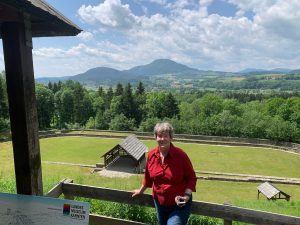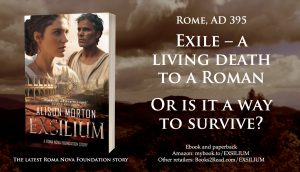The setting for Roma Nova
by Alison Morton

Imagining Roma Nova – Or is it real?
Ever since I read Violet Needham’s Stormy Petrel series as a child I’ve been caught by the idea of imaginary countries in Central Europe. Needham’s books for children invoke a romantic ‘otherwhere’, making it familiar, with a subtle, understated magical tone. Possibly seeming old-fashioned now, she’s very much the unsung, and sadly unknown, mother of modern fantasy with a mix of heroism, sacrifice and honour. At first her books were deemed by (grown-up) publishers to be too complex for children, but the story goes that one of the children of a family director at William Collins publishers loved the story, so it was accepted for publication. Talk about serendipity!
A little older, I was entranced by The Prisoner of Zenda and its sequel Rupert of Hentzau – classic examples of ‘Central Europe’. I thirsted after everything I could find about this amorphous region with no defined boundaries but a definite idea of itself. The Austro-Hungarian Empire seemed to be a concrete representation, but it wasn’t quite. When I learnt German, I found many ideas and writings about Mitteleuropa as a concept. As an adult, I found The Radetzky March by Joseph Roth to be a sweeping history of heroism and duty, desire and compromise, tragedy and heartbreak, a story over generations that lasts until the eve of the First World War. But that empire was vast, diverse and autocratic. Like the Ancient Roman Empire, it collapsed under its own weight and the pressure of people’s desire for their own homeland and self-governance, whether by conquest or democracy.
With all that in mind, my even greater obsession with all 1,229 years of Ancient Rome and a reasonably good knowledge of the alpine regions, I dreamt about an ideal place for the setting for my Romans seeking a new home. But it would be a small colonia, not an empire! It had to be fertile enough to sustain people, defendable and off the beaten track. So I started researching…

Imagine my delight when I found in real history that at the dusk of the Western Roman Empire people had actually established safe places in the mountains called Fliehburgen. A number of these successfully protected their population during the barbarian invasions, sometimes developing into permanent settlements for decades in the most dangerous periods. And for the Roma Novans, this became necessary in the years after the story in EXSILIUM.
Over their history, the Roma Novans, cultivated their land, built their cities, suffered invasion, rebuilt their cities, extended their holdings, negotiated treaties and managed to survive into the 21st century when the first modern Roma Nova adventure takes place in INCEPTIO.
What does Roma Nova look like in the 21st century?
It’s an alpine country with lower lying valleys a few small towns (Castra Lucilla to the south of the main city, Brancadorum at the east, Aquae Caesaris to the west) and a river city full of columns, a forum, Senate house and temples. High mountains and hills to three sides, although very useful for defence in past ages, keep the 21st century pilots from Air Roma Nova (and most international airlines) on their toes when landing their passenger aircraft after a long haul flight!
Sadly, you can’t use Google Maps to view Roma Nova’s geography from space nor load a Wikipedia page for its history. But inventing a country doesn’t mean you can throw any old facts into your book. They have to hang together. Geography is very important as you need to know what crops they can grow – spelt, oats, olives in sheltered areas, vines, vegetables and fruit – and what animals they raise – cows, sheep, horses, pigs, poultry, etc.

To look back to when those first Roman dissidents left Italy in AD 395 and trekked north to found Roma Nova, I also needed to deepen my specific knowledge about Roman life and culture at that time: their mindset, their customs, their concerns, their ways of doing things. As a reference, the first chapters of Christopher Wickham’s book The Inheritance of Rome draws a clear and detailed picture.
With the Roma Nova books, I’ve used terms that people might already know like the Roman sword, gladius, greeting such as salve, solidi as money, ranks like legate and centurion. But I’ve made the gladius carbon steel, the solidi have currency notes, debit cards and apps as well as coins, and I’ve mixed in other European military ranks such as captain in with traditional Roman ranks. It gives a sense of history that’s gone forward and adapted to the modern age.
Ancient Romans were fabulous engineers and technologists, organised and determined to apply practical solutions to the needs of their complex and demanding civilisation, so I’ve positioned them in the 21st century at the forefront of the communications and digital revolutions.
The silver mines in Roma Nova’s mountains and the resulting processing industry that underpinned Roma Nova’s early economy, and still play an extremely important role in 21st century Roma Nova, are another allusion to ancient Rome. Silver was a big reason the Romans wanted Britannia. Dacia (Romania) and Noricum (Austria) in central Europe were also of special significance to ancient Rome, as they were very rich in high quality deposits of silver, as well as iron ore, some gold and rare earths. Giving Roma Nova extensive silver deposits provides a strong, plausible reason for its economic survival through the ages.
I also wanted my imaginary country to be near Italy and Austria for international connections. So it had to be in south central Europe. In the end, I pinched Carinthia in southern Austria, and northern Slovenia as my models. And in summer 2023, I went to the old Noricum capital of Virunum, near Klagenfurt in Austria and was thrilled to visit breathe in the air of ‘Roma Nova’.
Alison Morton © March, 2024
Alison’s social media links:
Connect with Alison on her thriller site: https://alison-morton.com
Facebook author page: https://www.facebook.com/AlisonMortonAuthor
X/Twitter: https://twitter.com/alison_morton @alison_morton
Alison’s writing blog: https://alisonmortonauthor.com
Instagram: https://www.instagram.com/alisonmortonauthor/
Goodreads: https://www.goodreads.com/author/show/5783095.Alison_Morton
Threads: https://www.threads.net/@alisonmortonauthor
Alison’s Amazon page: https://Author.to/AlisonMortonAmazon
Newsletter sign-up: https://www.alison-morton.com/newsletter/

